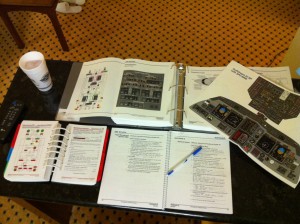An airplane is a lot like an onion: there are countless layers to peel back. I’ve been flying the Gulfstream IV-SP for five years now, and on every trip I learn something new. Most recently a mechanic informed me that it was legal to fly the airplane with one of the wingtips missing! How’s that for a revelation?
The one constant in the life of every professional aviator is learning. We have to be experts on aviation law, meteorology, aerodynamics, aircraft systems, human physiology, aeronautical decision-making, and dozens of other topics. Much of our learning occurs through practical experience, but even after reaching the highest certificate and rating status, we still undergo regularly scheduled and federally mandated training of one sort or another. We simply are not allowed to fly without it.

Every six months I head to Dallas for a long week of recurrent ground and simulator training on the Gulfstream. We review every aircraft system, from hydraulics and electrics to pressurization, engines, fuel and oil systems, and more. We then get to experience various failures and extreme flying conditions in a full motion simulator. The week ends with oral and practical testing. Then there are the international procedures training, emergency training, courses on FAA regulations and company policies, hazardous materials handling, TSA/security procedures, CPR training, and so on. As a flight instructor, I also take a refresher course on teaching fellow pilots every 24 months.
Pilots take this stuff pretty seriously. Many of us go beyond the required elements, pursuing what I call ‘electives’. For instance, I frequently fly tailwheel and aerobatic aircraft in order to keep my manual flying skills at the highest possible level and ensure I’m fully prepared to deal with any upsets caused by windshear, wake turbulence, autopilot malfunction, severe weather, or other causes.

Pilots share experiences, delve into maintenance manuals, and read aviation magazines. We’re even known to pore over accident reports. It sounds morbid, but learning what not to do can be as powerful and important a lesson as anything you’ll find in a textbook. You never know what tiny morsel of information might save the day when the chips are down. When you put it all together, the final result is what FlightSafety refers to as “the best safety device in any aircraftâ€: a well-trained pilot.
It can be difficult to reconcile all the training I’ve taken over the years with the fact that I still don’t “know it allâ€. But because aviation is so unforgiving of carelessness or inattention, the learning must continue. In a larger sense, it’s part of the human condition. Much like a flower, a human cannot remain static. We’re either blooming or wilting.
I remember the day I earned my pilot certificate. It was a beautiful Christmas Eve nearly two decades ago, but it still feels like yesterday. The examiner sat me down and solemnly said that the piece of paper she was handing me wasn’t proof that I had reached the pinnacle of flight, but rather was simply a “license to learnâ€. I’ve tried to take that message to heart, and as I got into my car, still floating on cloud nine after my check ride success, I promised myself that the day the learning stopped, it would be the sign: I’d hang up my headset and walk away from the cockpit for the last time.
This article first appeared in the November, 2016 issue of Jetgala Magazine.

I have occasionally let other subscriptions lapse, but I have always gotten the NTSB Reporter every month. A decade of reading it is very sobering.
And I think at the tail end of your flying career you should be allowed to coast a little. I don’t think even Bob Hoover learned a lot on his last ten flights, but I think he enjoyed them a lot, possibly as much as his first ten.
That would have been a fun question to pose: what have you learned from your last ten flights? I don’t know what Hoover would have said, but one can imagine the answer would have been both entertaining and inspired.
Should we be allowed to coast at the end? I’m not so sure. You can crash just as easily on your last flight as on your first one. In fact, pilots *have* crashed on their “fini” flights. There are always things to be learned — if we are open to taking the lesson. Perhaps it’s just a part of professionalism to make that debrief part of one’s standard operating procedure.
Every time I went to recurrent training, my goal was always to learn something new before starting that recurrent training session. Learning at least one new tidbit each time was a successful training period.
Great strategy, Charles! Sometimes I see people who set the goal of learning *everything* possible in a single recurrent. I’m not sure that’s even possible. Back in my theatre and opera days, I remember the sage advice I got from a director: he told me that even if he’s got a hundred notes for a singer after a rehearsal or performance, he’ll only convey a half dozen of them to the performer. In his experience, that’s all a person can truly absorb at one time. Overwhelm them with too much information and they won’t remember anything.
Many flight instructors (including those at Flight Safety and CAE, I noticed) give similar advice to students right before a checkride: don’t cram. Just relax and rest up. You’ll actually perform better that way.
Beautiful words my friend. I too troll the internet and sift through the FBO coffee tables for gold nuggets of information that may serve as the spark of divine intervention that keeps me aloft for one more ride. I always look forward to and value your insights and observations. Keep it up Rapp.
Thanks CM! I think it was easier to find those nuggets when we were new to aviation. They were everywhere — but only because our personal base of knowledge and experience was small back in those days. Of course, some of what we were exposed to may have been incorrect, and we were ill-equipped to know the difference. The advantage we have at this point in our careers is that we are (hopefully) a lot better at picking out the gold nuggets and leaving behind the steaming brown ones.
Another informative Ron Rapp, well-written article. He is a great asset to the aviation community @aceabbott
You’re too kind! Thanks Ace, and happy holidays!
Great article Ron. One point you touched on is: PILOTS SHARE EXPERIENCES. Example, the Head Test Pilot from Gulfstream was in our class and shared the problem a Gulfstream had with a gear (a main gear wheel stuck on the gear door) that would not go up or down. One thing Gulfstream had the crew do was touch down (firm) and go around. TEST PILOT: we will never suggest that procedure again. Question: how close did the wing get to the ground? Answer: WE WILL NEVER SUGGEST THAT PROCEDURE AGAIN. Experiences are one of the best teachers
I can only imagine what a firm landing on a single main landing gear leg would have done as the airplane banked around the center of gravity! I love stories like that because they’re the kind of thing I definitely do NOT want to learn through personal experience. Much better to get a chuckle over them in a nice, air-conditioned classroom as someone *else* relates the story.